#hesperus deity
Text




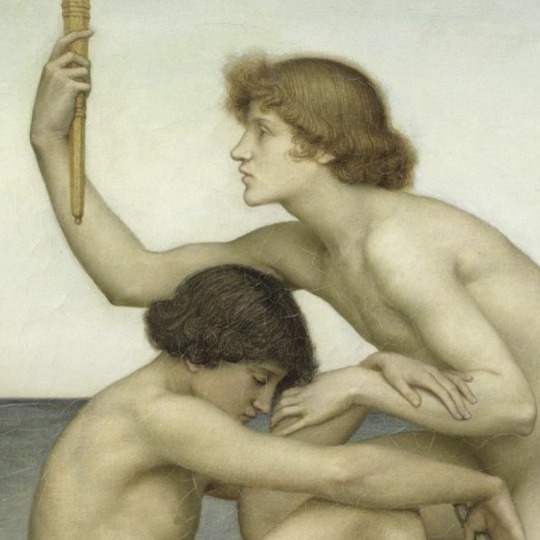

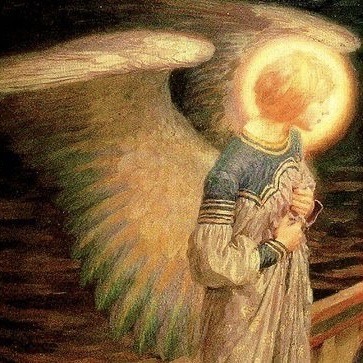


What is love? It is the Morning and the Evening Star.
— Sinclair Lewis
#greek mythology#greek gods#greek pantheon#hellenic polytheism#hellenic#hellenic gods#hellenism#greek myth#ancient greek mythology#hellenic deities#hellenic worship#hellenic polythiest#hellenic pagan#theoi#theoi worship#helpol#greek deities#moodboard#aesthetic#phosphorus#phosphorus deity#lucifer#lucifer deity#deity work#deity worship#pagan#paganism#Eosphorus#hesperus#hesperus deity
307 notes
·
View notes
Text

Red-figure vase-painting of Nyx, Selene, Hesperus, 4th century BC.
The gods of the night - Nyx, Hesperus and Selene - are traveling across the sky. Nyx, goddess of the night, leads the procession with her arm raised. She is followed by Hesperus, god of the evening star, who is depicted as a head surrounded by the shining halo of his star. Selene, goddess of the moon, appears last, seated on a horse in a side saddle, her fluttering garment forming the shape of a crescent moon.
#underworld#nyx#nyx deity#hellenic gods#hellenism#hellenic polytheism#hellenic pagan#hellenic deities#helpol#hellenic paganism#theoi#theoi worship#greek myth art#greek myth#greek gods#greek mythology#deity work#selene#selene deity#hesperus#hesperus deity#paganism#pagan
61 notes
·
View notes
Text
Tarot Card Associations for Hellenic Deities
Fool - Dionysus, Hermes, Pan, Ate, Gelos, Momus, Horme
Magician - Hephaestus, Hermes, Hecate, Aristeaus, Circe, the Muses, Apollo
High Priestess - Hecate, Persephone, Hera, Circe
Empress - Hera, Aphrodite, Demeter, Hestia, Gaia, Rhea
Emperor - Zeus, Hades, Poseidon, Ares
Hierophant - Demeter, Persephone, Hecate, Hestia, Hera, Gaia, Rhea
Lovers - Aphrodite, Eros, Dionysus, Adonis, Hera, Philotes
Chariot - Hermes, Charon, Iris, Morpheus
Strength - Athena, Ares, Heracles, Nike, Bia, Kratos,
Hermit - Hades, Hestia
Wheel of Fortune - Hermes, Tyche, the Fates, Zeus
Justice - Athena, Themis, Nemesis, Astraea, Apollo
Hanged Man - Hermes, Harpocrates, Prometheus, Psyche
Death - Hades, Thanatos, Dionysus, Charon, Persephone, Ares
Temperance - Athena, Demeter, Artemis, Harmonia
Devil - Dionysus, Pan, Comus, Ate, Priapus
Tower - Ares, Poseidon, Deimos, Phobos, Eris, Moros, Enyo, Hybris
Star - Aphrodite, Artemis, Astraea, Urania, Hermes, Eos, Hesperus
Moon - Selene, Artemis, Hecate, Nyx, Hypnos, Erebus
Sun - Apollo, Helios, Hemera, Hyperion
Judgment - Zeus, hades, Athena
World - Hermes, Demeter, Gaia, Hestia, Harmonia, Pan, Tyche
#I havent seen a compiled list like this#so I figured I'd give it a shot#I wanted to include lesser-known deities too#helpol#greek gods#witchblr#hellenic polytheism#tarot#paganism
459 notes
·
View notes
Text
OKAY
I think we need to discuss something that I’ve literally never heard any other practitioners talk about but I think it’ll immediately clear up A LOT of confusion! This is obviously my own upg so take it with as much validity as you please.
When doing any kind of work with any kind of deity, you really need to understand the concepts of archetypes and syncretism.
Religion, faith, and mythology, it’s all a big mess. Our clumsy archaic human language and our tendency to destroy and distort information means that the ancient world is really, to our modern understanding, A LOT (and I mean a LOT) of hypothesizing.
We often use the same words to describe different concepts, mix up names, combine names, and misunderstand each other. Such is the nature of humanity.
Theology is always fluid. Different entities have different cultural associations, some major entities or characters are even shared among multiple groups of people. Syncretism means that groups of people develop their ideas with the influence of other groups of people, though shifted to make sense for their personal experience.
My favourite thing in the world is when different religions share stories- viewing history from totally different perspectives- Retelling the same events through the scope of their theology.
This is why we have archetypes. There are many goddesses of love and sex that are associated with the planet that is commonly known as Venus. Why these archetypes emerge in the way they do? That’s up for you to debate with yourself.
The question of whether Aphrodite is Astarte or Ishtar or Lucifer or Helel or Eosphoros or Hesperus is not a question that can be answered entirely objectively. It can never be proven and it can never be disproven. Because sometimes the answer is yes, sometimes the answer is definitely no, and sometimes it’s really hard to tell.
The way that we all experience the energy that is “Venus” is going to be different. If she definitely feels like the same energy as Astarte to you, then that could be the case. There’s no objective authority on reality or faith. There is no reason why the findings of 1000 year old magis are more legitimate than yours. Study, learn, experiment.
I like to imagine it similar to colors. We all agree that wavelengths between 620 to 750 nm are red. We have silly little cones in our eyes that work with our brains to turn information into color. But we all understand that there are thousands of shades of red, and some people can’t even see red. Do you see where I’m going? I hope this makes sense.
Because of the way that we interact with reality, there are as many Aphrodite as there are people who believed in Aphrodite- and this is true for every God (at least in my silly little opinion).
There are as many variations in her energy as there are variations of people who follow her.
I try to scope this around what Jophiel told me once. YHWH created him, sometimes. But not at the moment when I was talking to him. When I asked him if Lucifer was the Satan of Christianity he said “sometimes” as well. It depends. It all depends. That’s the beauty of this weird wacky thing that we do.
Anyways,
I don’t know how else to write this but to say some people aren’t compatible with every archetype lol. This is totally okay though, it’s not anyone’s fault! It’s just like … spiritual chemistry. Alchemy? Stay with me!
Nature has laws. If you try to push against these laws you will experience difficulty and suffering. ☹️
Nature creates certain compounds. Stable compounds thrive 🙂 and unstable compounds explode ☹️. Interactions create products and outputs. When two or more elements that are not compatible are introduced they may have a volatile reaction.
I will not claim to know how divinities operate. This is all just my silly billy pondering. But I do know for fact, that at least in my experience, certain entities that share the same address interact with different people in different ways- and some entities will only respond to you under a specific face. Some entities will share faces, and some won’t even respond to you at all.
I’ll use a couple personal examples for reference.
When I first started working with Prince Cerberus, I addressed him using his Goetic name Naberius, as recorded in the Lesser Key of Solomon. I used his sigil and addressed that name.
One of the first things that came through crystal clear was his request to not be called Naberius. He made it very clear to me that he wanted to he called Cerbere or Cerberus, or that I could make up a personal name, but never should I use Naberius. He did not give a reason but he was firm on it.
Now, does this mean that we all can’t use the name Naberius and that we should all blacklist the name? NO! and this doesn’t mean that anyone who works with Naberius is disrespecting Cerberus!!!
For whatever reasons, I don’t know why, my Naberius is Cerberus. I don’t know if Naberius and Cerberus are the same entity or not, I just know that when I think of Naberius I get forwarded to Cerbere. I’m still able to use Naberius’ sigil, but I always get Cerberus.
That might not be true for you. That might not even be logical. That’s just the way that my spirit interacts with that spirit.
I’ve been a long time admirer of Lord Hermes. I approached him and tried desperately to gain his favor, but he refused 💔💔. He made it pretty clear that it wasn’t going to happen through a few ways, and since then he’s repeatedly rejected me…
lol 🥲
I was confused about that for a while, until I started getting hints towards Lord Mercury.
I can’t explain why, I have no idea what the real reason behind this is, but I feel extremely compatible with Mercury, but not with Hermes, like at all. Their energy feels quite separate and different to me. My Mercury isn’t quick like silver, he’s actually quite slow and contemplative.
I was bummed to not be able to establish a “work” relationship with Hermes but it’s probably for the best. Mercury is an excellent teacher.
What I mean to say through all of this rambling is that these things are not concrete. My Astaroth is only Astarte sometimes. Sometimes they feel very similar, sometimes they feel very distinct.
It’s important to remember that the Gods are not one thing, but many things at once. The answers to these questions are all variable. Only you can find the answers for yourself.
If you read this far you’re a real one 🫡
#magick#witchcraft#occultism#pagan#demonology#paganism#witch community#witch aesthetic#witchblr#grimoire#deity witchcraft#deity work#luciferian witch#lucifer devotee#goetia#angelology#eclectic pagan#hellenic paganism#paganblr#hellenic pagan#pagan witch#pagan blog#deity worship
73 notes
·
View notes
Text

The god Hesperus sits on a throne and holds a tall torch. Around him are Apollo-Helios (identifiable by his halo), Aphrodite (crowned), and other deities. Wall painting in the Fourth Style from the exedra of the House of M. Gavius Rufus (VII.2.16) at Pompeii; now in the National Archaeological Museum, Naples. Photo credit: ArchaiOptix/Wikimedia Commons.
#classics#tagamemnon#Ancient Rome#Roman Empire#Pompeii#Greek religion#Ancient Greek religion#Hellenic polytheism#Roman religion#Ancient Roman religion#religio Romana#Dionysus#Dionysos#Helios#Aphrodite#art#art history#ancient art#Roman art#Ancient Roman art#Roman Imperial art#wall painting#fresco#Fourth Style#NAM Naples
523 notes
·
View notes
Note
Your sea monkey au is good as hell!!
Also haii im still new here lol, but Hermes is honestly so so intriguing too. he's immortal? makes me wonder how the team would "defeat" him as an opponent. AND hes got goons? theyre not goo? i dig the change of pace of that. im not familiar with the poly au yet, but if you're open to ramble about Hesperus id like to hear about his interactions with his other (half?) siblings (if theyre in the same au that is i suppose) or even just his disposition with his parents, and if they're particularly supportive of his magic studies. AUGh your ocs are so COOL dude this is season 5 to me I wanna hear more and catch up with your previously works so bad ;w; it is a feast of content. Thank you for your service to this earth
Thank you first off. I'm really glad you're enjoying the sea monkey au and various other au's and ocs. Lots to talk about so, on to answering questions.
Hermes is a fun character that I need to write more for honestly. He's not really a bad guy at heart. More like someone who has been through a lot of trauma and is going about different methods to prevent others from ending up the same way he had for about ten years.
He was originally a NASA test monkey, in a test capsule during the space race era. His capsule was not expected to come back. And it didn't. Hermes nearly died there as air was running out. Then some space deity came across him and on a whim, gave him his sentience and immortality.
That alone was traumatic, but the ten years in the games galaxy (which, is it's own whole thing I could get into) was just as traumatic if not worse. This place is where Hermes got a lot of his current followers.
Defeating him? There are ways. Trapping him in one place, and electricity does slow his responses. There is also his reaction if there's no air. Technically, he won't die with no air. But no air reminds him of that moment when he die almost die and he would fall into a terrible panic attack.
I don't think the team would go for that tactic.
A lot of lore for a character that my original concept for was "villain that is a war lord but talks like he's from shows like "Leave it to Beaver".
Now, poly monkey's au (and sometimes poly monkeys soul bond au which is it's own thing) is the monkey members of the team all in a relationship. (Hermes occasionally involved. )
As for Hesperus, good questions. I think both his parents would be concerned at first. Gibson tries to make sense of Hesperus's system of finding new spells which seems to involve math and stars. But he doesn't quite get it.
He's probably one of he quieter kids. Get along well with Cooper ( Copper being the book smart son of Gibson and Otto ) and Eclipse ( Antauri and Mandarin kid, things he's the emo edge lord kid, he's actually the drama club kid) . Quasar ( Sprx/Nova kid that is clever, loves explosions and inventing things and full of mischief and being silly) always asking him about the explosives' spells.
And that's what I have on him for now. Hope you don't mind the big info dump. There is so much to talk about with these characters and aus. And thank you for asking about them.
4 notes
·
View notes
Text
Beelzebub - Wikipedia
Hebrew Scriptures
The source for the name Beelzebub is in the Books of Kings (2 Kings 1:2–3, 6, 16), written Ba'al-zəbûb, referring to a deity worshipped by the Philistines. The title Baal, meaning "Lord" in Ugaritic, was used in conjunction with a descriptive name of a specific god. Opinions differ on what the name means.
In one understanding, Ba'al-zəbûb is translated literally as "lord of (the) flies".[2][3][4][5] It was long ago suggested that there was a relationship between the Philistine god, and cults of flies—referring to a view of them as pests, feasting on excrement—appearing in the Hellenic world, such as Zeus Apomyios or Myiagros.
This is confirmed by the Ugaritic text which depicts Ba'al expelling flies, which are the cause of a person's sickness.[6] According to Francesco Saracino (1982), this series of elements may be inconclusive as evidence, but the fact that in relationship to Ba'al-zebub, the two constituent terms are here linked, joined by a function (ndy) that is typical of some divinities attested to in the Mediterranean world, is a strong argument in favor of the authenticity of the name of the god of Ekron, and of his possible therapeutic activities, which are implicit in 2 Kings 1:2–3, etc.[7]
Alternatively, the deity's actual name could have been Ba'al-zəbûl, "lord of the (heavenly) dwelling", and Ba'al-zebub could have been a derogatory pun used by the Israelites.[8][9][10]
The Septuagint renders the name as Baalzebub (Βααλζεβούβ) and as Baal muian (Βααλ μυῗαν, "Baal of flies"). However, Symmachus may have reflected a tradition of its offensive ancient name when he rendered it as Beelzeboul.[11]
Testament of Solomon
In the Testament of Solomon, Beelzebul (not Beelzebub) appears as prince of the demons and says[12] that he was formerly a leading heavenly angel who was[13] associated with the star Hesperus (the normal Greek name for the planet Venus (Aphrodite, Αφροδíτη) as evening star). Seemingly, Beelzebul here is synonymous with Lucifer. Beelzebul claims to cause destruction through tyrants, to cause demons to be worshipped among men, to excite priests to lust, to cause jealousies in cities and murders, and to bring about war. The Testament of Solomon is an Old Testament pseudepigraphical work, purportedly written by King Solomon, in which the author mostly describes particular demons whom he enslaved to help build Solomon's Temple, with substantial Christian interpolations.[14]
Christian Bible
In Mark 3:22, the scribes accuse Jesus Christ of driving out demons by the power of Beelzebul, the prince of demons. The name also appears in the expanded version in Matthew 12:24,27 and Luke 11:15, 18–19, as well as in Matthew 10:25.
Jesus knew their thoughts and said to them, "Every kingdom divided against itself will be ruined, and every city or household divided against itself will not stand. If Satan drives out Satan, he is divided against himself. How then can his kingdom stand? And if I drive out demons by Beelzebul, by whom do your people drive them out? So then, they will be your judges. But if I drive out demons by the Spirit of God, then the kingdom of God has come upon you."
—Matthew 12:25-28
It is unknown whether Symmachus the Ebionite was correct in identifying these names. Zeboul might derive from a slurred pronunciation of zebûb; from zebel, a word used to mean "dung" in the Targums; or from Hebrew zebûl found in 1 Kings 8:13 in the phrase bêt-zebûl, "lofty house".
In any case, the form Beelzebub was substituted for Beelzeboul in the Syriac translation and Latin Vulgate translation of the gospels, and this substitution was repeated in the King James Version, the resulting form Beelzeboul being mostly unknown to Western European and descendant cultures until some more recent translations restored it.
Beelzebub is also identified in the New Testament as the Devil, "the prince of demons".[15][16] Biblical scholar Thomas Kelly Cheyne suggested that it might be a derogatory corruption of Ba'al-zəbûl, "Lord of the High Place" (i.e., Heaven) or "High Lord".[17]
In Arabic translations, the name is rendered as Baʿl-zabūl (بعلزبول).[18][19]
3 notes
·
View notes
Photo

— ☄ CELAENO ! aka. calista montalván, 29, (ana de armas FC)
is looking for their current or budding romantic interest.

The general vibes of this connection is a romantic base, Calista is a very amorous person and this would be either a new but not exclusive romantic relationship, or one that is budding and possibly in the ‘will they, won’t they’ stage. I am also open to the possibility that Calista may be ‘the other woman’, if that is a route that interests you. While Poseidon is my first preference due to the lore between him and Celaeno I’m open to others, but I would specifically love to foster some level of a deity connection as well as a mortal connection between the two.
suggested fcs: chris evans, michiel huisman, jason momoa, jesse williams, rahul kohli, sean teale, lucien laviscount, manny jacinto, andrew koji, tommy martinez, casey deidrick, dev patel, matthew gray gubler, chris hemsworth, ekin koç, milo ventimiglia, nana-kofi siriboe, tom ellis, lance gross, ben barnes / melissa barrera, bruna marquezine, brenda song, çağla demir, cierra ramirez, samara weaving
key connection details.
disallowed fcs: jacob elordi, taylor swift, ariana grande, demi lovato, miley cyrus, sidharth malhotra, emma mackey, penn badgely, joe keery, lee soo-hyuk, sydeny sweeney
suggested/requested ethnicity: N/A
deity suggestions: poseidon (first & main preference!), zeus, atlas, crius, astraeus, helios, urania, hesperus, hercules, morpheus, chiron / deities that have something to do with stars, astronomy, sea or the underworld is preferable! / none of the Pleaide Nymphs!
gender preference: AMAB, male, masc, etc. if you are set on a fem FC for this connection, please contact me first!
wc name: UTP
wc age: 29-45 (M) / if we a FxF ship; (27-37)
key features: None physical, however Calista does speak Spanish so if they are bilingual that could be a fun thing to have in common if you like.
how long have they known each other?: A maximum of eight months (when Calista arrived on the island), or at the lowest, two or three months.
where did they meet?: on Magnetic Island, likely whilst Calista was doing some street art/painting or while she was working at Cygnus Restaurant.
connection description.
canon details this wc would know about calista: her nickname is ‘cali’, but doesn’t have a preference for the nickname vs. her full name, they may know she works in the adult industry (onlyfans), but definitely that she is a street artist and that she is a waitress at cygnus restaraunt, her first language is spanish but she is fluently bilingual, she has a pet eastern pygmy possum, named ‘nynaevia’. she was a professional equestiran and also has a pet horse, a black arabian named ‘fliss’. calista is a very flirty, personable and bright personality, there are more details in her intro post!
hc’s for this wc: they may have called her ‘Liss’ or ‘Lista’, which could have been a pet name or something cute like that, and Calista will have a specific pet name for your muse too. Calista would definitely have encouraged them to come horse riding with her, Calista would have certainly painted your muse several times, they would know that Calista has a deep love of the night and of the clear, new moon skies. Anything more, we can plot together!
do you require the applicant to contact you before applying?: you are definitely welcome to, I do ask that if you are set on a F muse that you contact me first! You can find me on Calista’s blog: @brightcelaeno or my main blog: @ascreamingecho
#wanted connection!#chris evans fc#jason momoa fc#jesse williams fc#rahul kohli fc#sean teale fc#matthew gray gubler fc#ben barnes fc#tom ellis fc
2 notes
·
View notes
Text
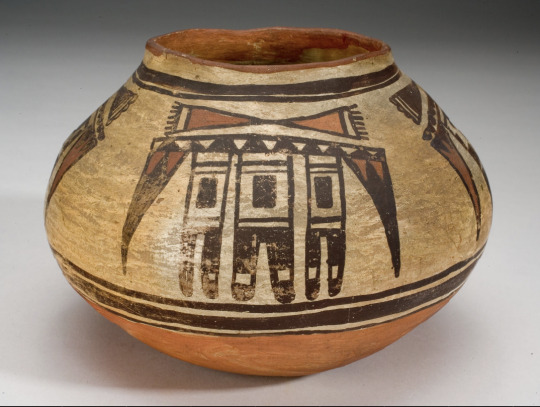
Bowl, undated artifact. Artist unknown. Davis Museum at Wellesley College, Wellesley, MA.
This ceramic bowl is decorated with a Navajo ‘House Pattern’ design, gifted from Mary Chamberlain to the Davis Museum at Wellesley College, measured at 4 5/16 in. x 6 11/16 in. (10.9 cm x 17 cm). The geometric design shares common traits with other Navajo designs decorating the home (ex. In rugs or other textiles), with the triangular shapes, diamond shapes, linear motifs and scattering of rounded edges. Symbolic meaning is embedded within these geometric designs, like how many triangles represent the mountains of the natural world. In Navajo culture, geographical boundaries were not set in stone through governments but loosely defined and contained within the two sacred mountains, Gobernador Knob and Huerfano Mesa, a region referred to as the Dinétah.
Mountain imagery can also represent the Four Sacred Mountains (the four directions). These are the four mountains along the boundaries of the Navajo Nation, where each is assigned a colour and direction, and is seen as a deity essential to Navajo survival. They are named in sunwise order: Sisnaajiní or Blanca Peak (blue, east), Tsoodził or Mt. Taylor (yellow, south), Doko'oosłííd or the San Francisco Peaks (black, west), and Dibéntsaa or Hesperus Peak (white, north). Lines are often symbols for rain. This bowl shows some Pueblo inspiration (the general shapes, line variety and line placement), but lacks the black-on-black technique Pueblo people use, making it a mix of Navajo and Pueblo imagery.
Home ceramics were often made by the women of the household, depicting spiritual journeys, ceremonial practices, creation tales, family lineage, mythology, tribe history and more. Many of these ceramics are imbued with reverence for the natural world.
SOURCES:
Jett, Stephen (1992). "An Introduction to Navajo Sacred Places". Journal of Cultural Geography. 13 (1): 29–39.
Pierce, Trudy (1992). Sky Is My Father (1 ed.). University of New Mexico Press. pp. 69–75, 90–96.
0 notes
Text

I present to you the most niche of deity memes
#niche deity fandom WYA#hellenism#hellenic polytheism#hellenic memes#polytheist memes#deity memes#hellenic shitposts#greek gods#eosphorus#hesperus#morning star#evening star
21 notes
·
View notes
Text
Hesperus & Eosphorus Notes (27/7-2020)
This is just the continuation of my notes on Hesperus and Eosphorus, Star of Venus. I decided to put it under a read-more to not bother anyone with a long post.
I have quite a lot to do today so the notes I’ll be sharing will be general. If anyone reading this is interested in knowing anything more, feel free to message me about it.
General notes:
They blend together in my head a lot more than I expected. I still see Them as separate beings of course, however I assume that due to the fact that They share many traits it is hard to tell them apart at times.
Hesperus is highly emotional as I thought; I started crying the other night because of something personal and while I was the one crying (obviously) it also felt like Hesperus was crying for me. That was a new experience to me, because while I feel sympathy and comfort from my Patron and other Deities when I’m down I’ve never felt as though a Deity is crying for me.
I believe They may rule over dreams because They’ve appeared in mine quite a lot lately. I usually have vivid dreams and have in the past written them down, but because I rarely do so anymore I struggle to remember them. But, something I do remember is dreaming about Hesperus and Eosphorus very often, usually scenarios where Their names come up randomly or spending time with Them.
I gave Them both flowers the other day, and Eosphorus’ withered and dried up very quickly. I doubt this is a bad sign though and think it might just have something to do with how fast He absorbs energy and whatnot. I will try to keep in mind for future reference that They probably like different flowers, though.
I’m very curious about Phosphorus and am disappointed with the lack of information there is on both Eosphorus and Hesperus of course, but also Their presumed “combined” form. A tarot reading I did on their personalities made it seem as though Phosphorus is simply a combination of traits from the brothers, but I’m not entirely sure about it yet.
They both seem to enjoy jazz and listening to music, and in general They’re very cheerful and excitable. Almost in a child-like way which I personally find endearing. I also find myself feeling protective towards Them quite a lot, like a mother towards her children almost.
Those are my notes for now. I don’t have any specific direction to go with these posts, but I reckon I’ll figure it out eventually. If I find the time for it I will make a compilation of the actual myths there are about these two along with the “official” info on them. I also plan to make a post of symbols, signs and offerings later one when I know Them better.
#personal#notes#hesperus#eosphorus#hesperos#eosphoros#vesperus#vesper#evening star#dusk-bringer#bringer of dusk#luciferus#lucifer#bringer of dawn#dawn-bringer#morning star#greek gods#greek deities#hellenism#hellenic polytheism#niche gods#hellenic gods#hellenic pagan#hellenic polytheistic#polytheistic pagan#paganism
14 notes
·
View notes
Text
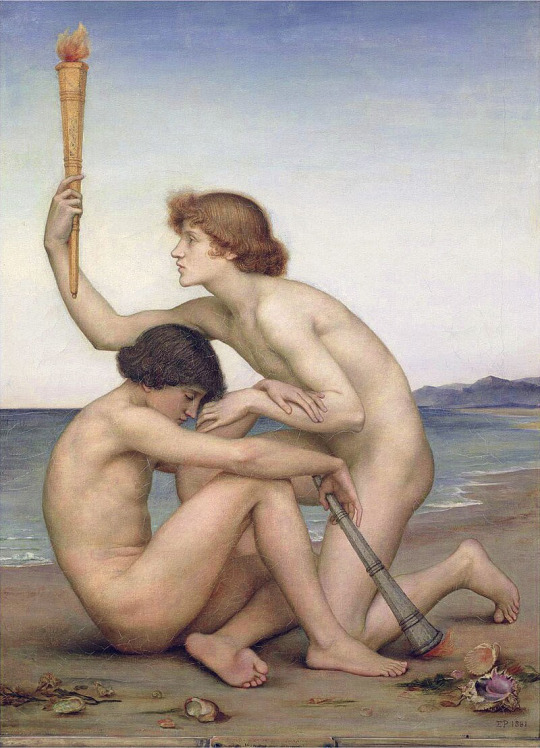
Phosphorus and Hesperus, 1881 - oil on canvas.
— Evelyn De Morgan (England, 1855–1919)
In Greek mythology, Phosphorus is the god of the planet Venus in its appearance as the Morning Star and Hesperus is the Evening Star, the planet Venus in the evening.
#greek mythology#greek gods#greek pantheon#hellenic polytheism#art#hellenic#hellenic gods#hellenism#oil on canvas#oil painting#greek deities#ancient greek mythology#greek myth#ancient greece#helpol#Phosphorus#Phosphorus deity#hesperus#Hesperus deity#oh i love them#painting#classical art#greek myth art#traditional art#evelyn de morgan#pre raphaelite#pre raphaelism#lucifer#lucifer deity#morning star
55 notes
·
View notes
Note
hello there!! (totally cool if u dont want to answer this) but i saw ur post of spiritual/religious red flags and i wanted to ask about the "lucifer is actually roman god" thing and why that would be a red flag? thanks!
Hello! I don't mind answering it.
So first of all, that list was a real spectrum with no clear indicator of severity, which I tried to disclose at the beginning. Some of the things on it are deeply harmful or subtly bigoted, while others are just kind of misinformed. Lucifer as a Roman god tends to fall into the latter, in my opinion.
I don't know your frame of knowledge coming into this, so I'm sorry if I over explain anything.
In Greek and Roman myth, there are a lot of anthropomorphic personifications that exist alongside the gods. Two of them are Phosphorus and Hesperus, the personifications of the morning star and evening star, or Venus as seen at dawn and dusk. That Latin corresponding word/name for Phosphorus is Lucifer, while Hesperus gets Vesper. So in the strictest sense of the word, there is a figure in Roman mythology (though in my opinion not a god per se) that is named Lucifer.
Where this gets messy for me is when people try to say that Lucifer as he is understood in Christian folklore is a Roman god. The only thing that links these two figures is a misunderstanding of an old translation, which I've brought up before here when discussing the actual lack of Biblical presence that Lucifer has by name.
As with many of the ideas on that list, there tends to be a best case scenario and a worst case scenario, and plenty of middling takes in between.
To me, when I hear someone say "Lucifer is a Roman god" in conversations about the Lucifer who's discussed in (most) Luciferianism, or the Lucifer as he's portrayed in Paradise Lost, or any other variation there of, the best I can hope for is that they're misinformed and incurious. It's the kind of take that falls apart with even a little research, so if it's being regurgitated as trivia, it seems more likely to me than not that they didn't actually bother to do any reading of their own.
What I tend to worry about, however, is that the individual in question might be trying to distance Lucifer (as he's commonly understood) from his cultural origins. While the blend and evolution of religious ideas is incredibly intricate and complex, there tends to be a blunt force version that's employed whenever people want to distance Christian or Jewish figures from their religions. I would say the "Lilith is Babylonian actually" crowd is being far more offensive with it, as they tend to debate actual Jewish people with their entire chests despite numerous citations that prove otherwise which they choose to willfully misinterpret. Likewise, it starts getting a bit Weird to me when people will try to claim that the spirits in the Ars Goetia are Old Gods™ just because some of them (and not all, mind you) have names that are taken from or inspired by existing deities. For example, the name Astaroth is thought to maybe be inspired by Astarte (despite belonging to a wildly different entity of a different gender) and Balam shares a name with a Biblical magician.
There is a fascinating web that can be studied picked at. I would love nothing more than to be a professional esoteric historian who's paid to spend all his time trying to suss out how much of ancient Canaanite mythology influenced later religious ideas and stories, or how Mithraism may have influence early Christianity. But when people are simplifying and exaggerating those connections to try and separate the figures that appeal to them from their cultural and religious roots... I have to wonder why. And I'm always hard pressed to think of a defensible reason.
Feel free to let me know if you have any other questions!
83 notes
·
View notes
Text
Asteri Discussion + Amren theory
(Crack theory)
“She exploded from that mortal shell, light blinding us. Light and fire.”
Amren emerging from the cauldron in her true form
Metaphorically, how would you describe a star? Not as in a body of gas in space but from the naked eye. Light? perhaps even fire? Bare with me, I’m looking too into this.
Now, let’s talk about the Asteri from Crescent City, which I think the fandom will find very interesting.
The 7 notable members of the Asteri are:
Austrus
Eosphoros
Hesperus
Octartis
Polaris
Rigelus
Sirius
This is going to sound very random, but I wanted to know the origins of these names and why I think they have some significant meaning behind them.
Austrus
I found a similar name, like many of the other names below, In Greek mythology, Astraeus or Astraios, means "starry" was an astrological deity, as he was the god of the dusk, Astraeus married Eos, goddess of the dawn. Together as nightfall and daybreak they produced many children who are associated with what occurs in the sky during twilight.
…I’m sorry, but did any of you notice the Nightfall and Daybreak connection. RUHN AND LIDIA??? AGENT DAYBRIGHT?? AGENT NIGHT??
•
Eosphoros + Hesperus (names added together because of similar meanings)
Eosphoros and Hesperus were the gods of the star (aster planeta) Venus. They were originally regarded as two distinct divinities--the first, whose name means "Dawn-Bringer," was the god of the dawn-star, while the second, "Evening," was the star of dusk.
Yes, LOTS of Dusk Court connections
•
Octartis
I didn’t find anything for “Octaris” BUT I found a star very similar to the original name. Sigma Octantis.
Sigma Octantis Sigma Octantis, officially named Polaris Australis is the current "South Star" (as opposed to the North Star).
•
Polaris
Polaris is a star in the northern circumpolar constellation of Ursa Minor. It is designated α Ursae Minoris and is commonly called the North Star or Pole Star.
After reading the meaning, I very suddenly remembered a theory I was doing in one of my first posts, I mean, it just cracked out of nowhere. (I know, all of you reading this are very confused)
•
Rigelus
Rigel, designated Orionis, is a blue supergiant star in the constellation of Orion, Rigel is the brightest and most massive component – and the eponym – of a star system.
Makes sense, right? Rigelus is the head/leader of the Asteri.
•
Sirius (Amren’s theory self)
The name Sirius is primarily a male name of Greek origin that means Burning Brightly.
This uncommon name is derived from the ancient Greek for "glowing". Sirius is the name of the brightest star in the night sky.
“She exploded from that mortal shell, light blinding us. Light and fire.”
I’ll have to remind you why I still stand for Amren being Sirius.
Brightest star? Glowing? “Light blinding us?”
Burning brightly? “Light and fire?”
•
See a pattern?
All the Asteri’s names are associated with stars or a majority of them are stars.
Also, the Asteri’s power is forged from stars.
“Though the descriptions of all the Asteri remain unknown, it is widely speculated that their true forms are an extreme form of raw power forged from the stars that inhabit whatever bodies they possessed until said form withered away from the strain.” - Asteri Wiki
This post is to stand and add to the theory that Amren is Sirius, an Asteri and have a talk about the Asteri and why some of the name origins are significant somehow.
#The Asteri#crescent city 2#Crescent city#Amren theory#Acotar theory#sjm#Sjm theory#sjm multiverse#sjm fandom#Acosf#bryce quinlan#Hosab#house of sky and breath spoilers#house of Sky and breath#Hoeab#house of earth and blood#a court of thrones and roses#acotar series#a court of silver flames
17 notes
·
View notes
Text
Greek Deities (male)
ACHELOUS - The patron god of the “silver-swirling” Achelous River.
Aeolus - Greek god of the winds and air
Aether - Primordial god of the upper air, light, the atmosphere, space and heaven.
Alastor - God of family feuds and avenger of evil deeds.
Apollo - Olympian god of music, poetry, art, oracles, archery, plague, medicine, sun, light and knowledge.
Ares - God of war. Represented the physical, violent and untamed aspect of war.
Aristaeus - Minor patron god of animal husbandry, bee-keeping, and fruit trees. Son of Apollo.
Asclepius - God of medicine, health, healing, rejuvenation and physicians.
Atlas - The Primordial Titan of Astronomy. Condemned by Zeus to carry the world on his back after the Titans lost the war.
Attis - A minor god of vegetation, fruits of the earth and rebirth.
Boreas - A wind god (Anemoi) and Greek god of the cold north wind and the bringer of winter. Referred to as “The North Wind”.
Caerus - Minor god of opportunity, luck and favorable moments.
Castor - One of the twins, Castor and Pollux, known as Dioskouri. Zeus transformed them into the constellation Gemini Cerus - The large and powerful wild bull tamed by Persephone and turned into the Taurus constellation.
Chaos - The nothingness that all else sprung from. A god who filled the gap between Heaven and Earth and created the first beings Gaia, Tartarus, Uranus, Nyx and Erebos.
Charon - The Ferryman of Hades. Took the newly dead people across the rivers Styx and Acheron to the Greek underworld if they paid him three obolus (a Greek silver coin).
Cronos - The god of time. Not to be confused with Cronus, the Titan father of Zeus.
Crios - The Titan god of the heavenly constellations and the measure of the year..
Cronus - God of agriculture, leader and the youngest of the first generation of Titans and father of the Titans. Not to be confused with Cronos, god of time.
Dinlas - Guardian god of the ancient city Lamark, where wounded heroes could find comfort and heal after battle. He was the son of Aphrodite.
Deimos - Deimos is the personification of dread and terror.
Dionysus - An Olympian god of the grape harvest, winemaking and wine, of ritual madness, religious ecstasy and theatre.
Erebus - Primordial god of darkness.
Eros - God of sexual desire, attraction, love and procreation.
Eurus - One of the wind god known as Anemoi and god of the unlucky east wind. Referred to as “The East Wind”.
Glaucus - A fisherman who became immortal upon eating a magical herb, an Argonaut who may have built and piloted the Argo, and became a god of the sea.
Hades - God of the Dead and Riches and King of the Underworld. Helios - God of the Sun and also known as Sol.
Hephaestus - God of fire, metalworking, stone masonry, forges and the art of sculpture. Created weapons for the gods and married to Aphrodite.
Heracles - The greatest of the Greek heroes, he became god of heroes, sports, athletes, health, agriculture, fertility, trade, oracles and divine protector of mankind. Known as the strongest man on Earth.
Hermes - God of trade, thieves, travelers, sports, athletes, and border crossings, guide to the Underworld and messenger of the gods.
Hesperus - The Evening Star – the planet venus in the evening.
Hymenaios - God of marriage ceremonies, inspiring feasts and song.
Hypnos - The Greek god of sleep.
Kratos - God of strength and power.
Momus - God of satire, mockery, censure, writers and poets and a spirit of evil-spirited blame and unfair criticism.
Morpheus - God of dreams and sleep – has the ability to take any human form and appear in dreams.
Nereus - The Titan god of the sea before Poseidon and father of the Nereids (nymphs of the sea).
Notus - Another Anemoi (wind god) and Greek god of the south wind. Known as “The South Wind”.
Oceanus - Titan god of the ocean. Believed to be the personification of the World Ocean, an enormous river encircling the world.
Oneiroi - Black-winged daimons that personified dreams. Paean - The physician of the Olympian gods.
Pallas - The Titan god of warcraft and of the springtime campaign season.
Pan - God of nature, the wild, shepherds, flocks, goats, mountain wilds, and is often associated with sexuality. Also a satyr (half man, half-goat).
Phosphorus - The Morning Star –the planet venus as it appears in the morning.
Plutus - The Greek god of wealth. Pollux - Twin brother of Castor, together known as the Dioskouri, that were transformed into the constellation Gemini.
Pontus - Ancient, pre-Olympian sea-god of the deep sea, one of the Greek primordial deities and son of Gaia.
Poseidon - Olympian Greek god of the sea, earthquakes, storms, and horses.
Priapus - Minor rustic fertility god, protector of flocks, fruit plants, bees and gardens and known for having an enormous penis.
Pricus - The immortal father of sea-goats, made into the Capricorn constellation.
Prometheus - Titan god of forethought and crafty counsel who was given the task of moulding mankind out of clay.
Primordial - A group of gods that came before all else.
Tartarus - The god of the deep abyss, a great pit in the depths of the underworld, and father of Typhon.
Thanatos - A minor god and the god of death.
Triton - Messenger of the sea and the son of Poseidon and Amphitrite.
Typhon - The deadliest monster in Greek mythology and “Father of All Monsters”. Last son of Gaia, fathered by Tartarus and god of monsters, storms, and volcanoes. He challenged Zeus for control of Mount Olympus.
Uranus - Primordial god of the sky and heavens, and father of the Titans.
Zelus - The god of dedication, emulation, eager rivalry, envy, jealousy, and zeal.
Zephyrus - A wind god (Anemoi). God of the west wind and known as “The West Wind”.
Zeus - God of the sky, lightning, thunder, law, order, justice, King of the Gods and the “Father of Gods and men”.
Information found on: https://greekgodsandgoddesses.net/gods/
45 notes
·
View notes
Text
A MYTHOLOGICAL ESSAY (TITANS)
Like many here, I love Greek mythology with its unlimited catalogue of gods and fantastic creatures. However, I've always had a problem adapting these stories. Beyond the writing of these figures which is an object of discussion in forums like these, I want to focus on a more A E S T H E T I C aspect.
Specially, about the Titans
NOW WHO ARE THE TITANS?
In Greek Mythology, the titans are the second generation of the gods (theoi) that ruled the cosmos, Cronus is the youngest of the titans when he overthrew his father, the primordial Uranus to later rule the heavens together with Rhea. To this point we know the famous story of Zeus against his father when he freed his brothers from the cage (A.K.A the belly) of Cronus and managed to defeat him and then he was sent to Tartarus.
Now my problem lies beyond its writing and symbolism, the design of this second generation of gods is a problem for me, especially in modern adaptations for the big screen and videogames. How many times have we not seen an adaptation and its design is completely "strange" to say the least?
BEHOLD THE TITANS
- God of War III (2010) -
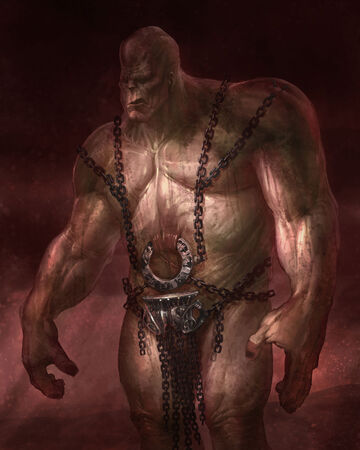
WOW, I didn't know Thanos signed with Santa Barbara Studios to work as a stuntman for these people.
- Wrath of the Titans (2012) -
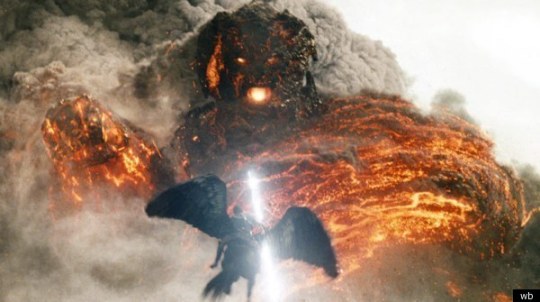
- Thank you Hollywood for making us believe that Kronos = Surtr (does not compute)
- Immortals (2011) -
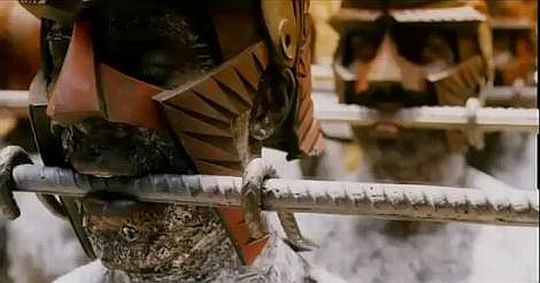

TRIVIA: Did you know that the titans had a strange kink with reinforcing bars :D (seriously, why grey?)
- Disney’s Hercules (1998-1999) -
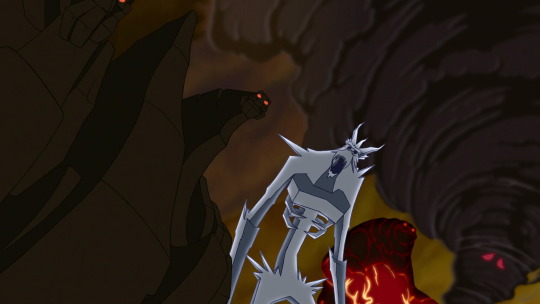
Ahhh...
BACK TO THE TOPIC
i mean, we can argue all day long that they as a representation of natural forces is normal to possess supernatural forms in comparison to their descendants the Olympians who represent the human elements of society.
H O W E V E R
I find it too convenient that only these figures have an over the top design compared to their younger generation, (Even the Primordial Gods who are the pure elements of the universe and at the same time the parents of the Titans, they don’t have this monstrous aspect, just look at Nyx and Gaia from Marvel Comics) or we have even seen sometimes how some Titans have human form (Special case, Rhea, Helios and Eos from the God of War saga)
- Gaia and Nyx from Marvel Comics -
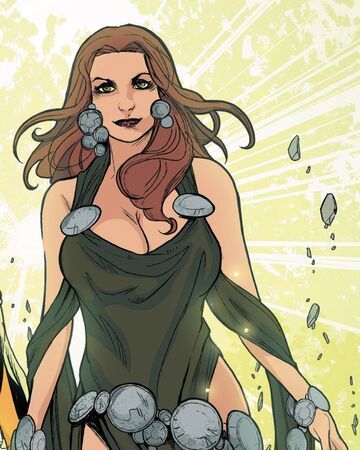

My primordial queens look better than their children... How is that possible?
- Helios, Rhea and Eos from the God of War saga -
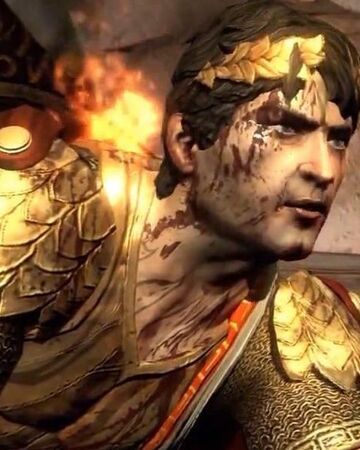
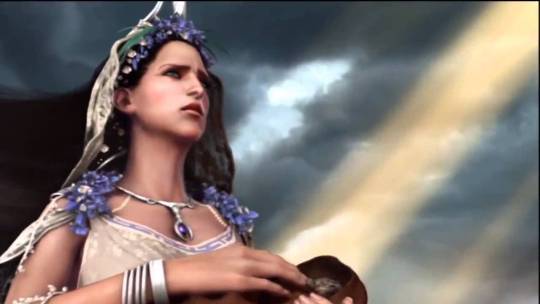

See? Designing characters like this is way better and more interesting than turning them into a generic foe as if they were taken from a Lord of the Rings bestiary.
Now, I can understand that this mistaken interpretation of these figures is due to the confusion of the Titans with the Giants (both groups are sons of Gaea who fought a war against the Olympic gods) So it’s kinda understandable that the confusion is palpable.
With all this covered there's someone who's wondering.
Is there any evidence of how the ancient greeks saw the Titans?
Fortunately the answer is YES . There is enough evidence to understand how this second generation of gods were seen by the ancient inhabitants of Greece, especially in two areas, sculpture and painting.
STATUES OF THE TITANS
- Farnese Atlas (150 B.C) -
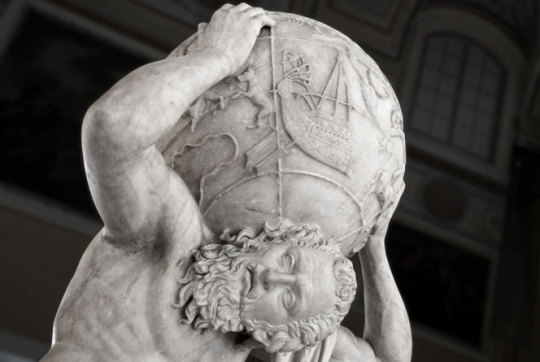
- Piece of an altar with Selene the moon titaness with either Phosphoros and Hesperus or the Dioscuri -
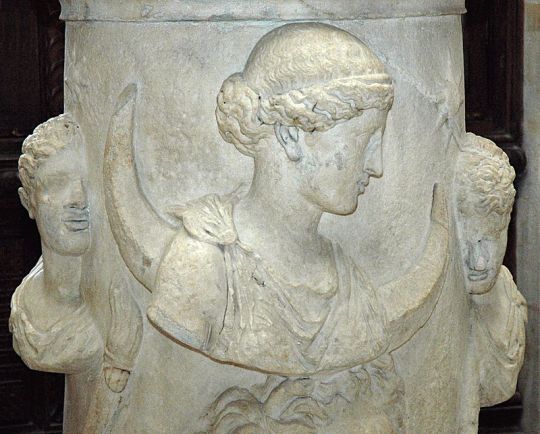
- Themis, the titaness of justice ( Chairestratos, c. 300 BCE) -
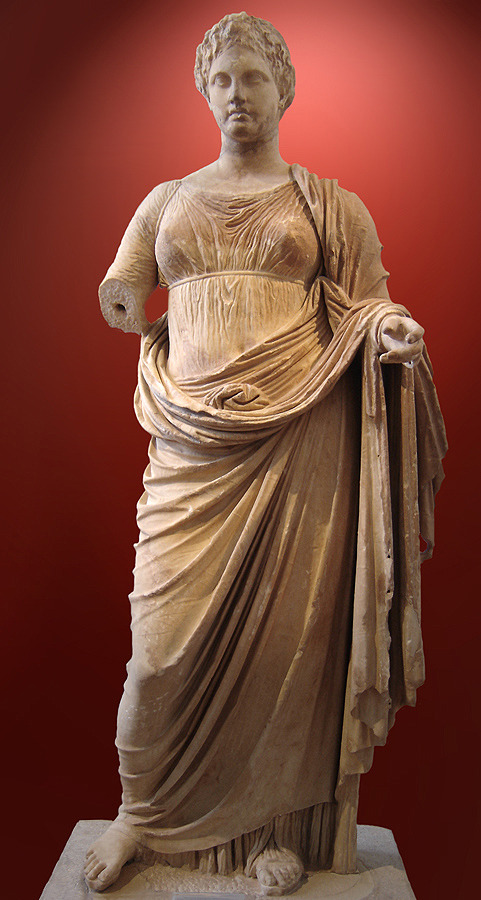
First of all, even if the former statues represent either titaness and a second generation titan (Atlas) We found no indication that these figures could be represented in a more exaggerated context.
But the most interesting part is the portraying of the titans in the old greek vase-paintings. WHY? Because the painting compared to the sculpture shows a more human focus on the gods, respecting their authority and power but implementing the qualities and defects that any mortal possesses. And the titans were not the exception when they were portrayed in this spectrum of the art.
AND THIS ARE THE PAINTINGS
- Atlas and Prometheus ( ca. 530 B.C.) -
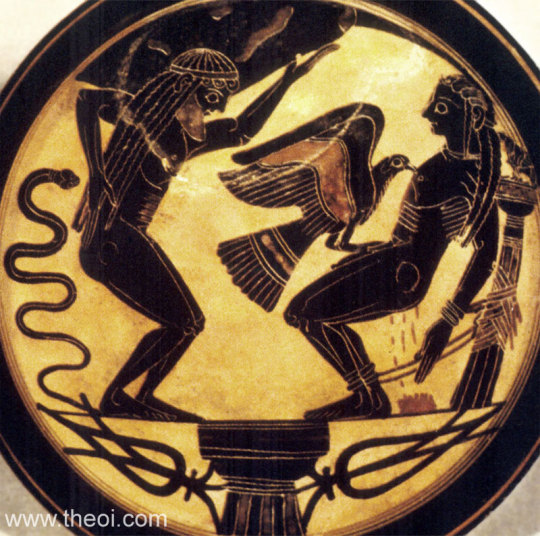
- Oceanus and Tethys (ca. 580 - 570 B.C.) -
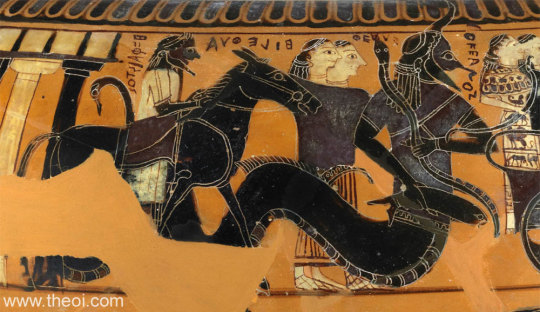
But for me, without a doubt, the most representative painting of the titans is this one.
- Cronus and Rhea (ca. 460 – 450 B.C.) -
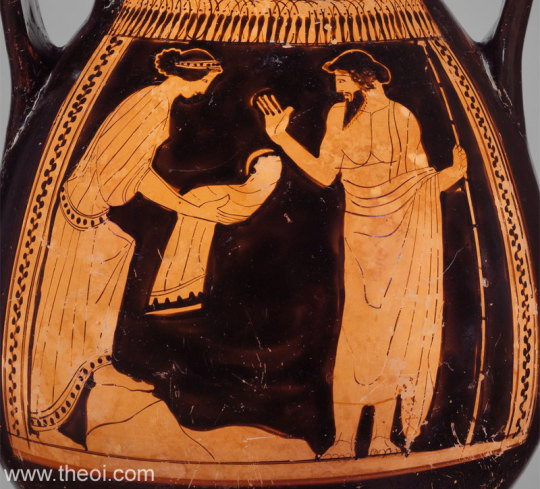
If one day I was asked about how the Titans looked like? I will show them this image.
The first time you see this painting, the first thing you can imagine is the portrait of a normal greek family, but once you know who they really are, your perspective about this couple changes, there are no elements so over the top as a giant and monstrous Cronus and a normal stature Rhea that sometimes can generate confusion in people. Perhaps in a way the ancient Greeks wanted their mythological figures not to be too far removed from human nature, so that the people could identify with their deities in the most humane way possible even if the titans were not such adored figures compared to their descendants, the point still stands.
IN CONCLUSION
Lately the stories of Greek mythology have taken a more intimate approach to the relationships with the Greek gods, the fantastic elements are still present, but that is not the main value of these stories. How these figures relate to each other on a daily basis is perhaps an example of how the Greeks saw their gods. Beyond the powers, the titles, they saw people with qualities and defects.
So, if one day there is an adaptation to the screen about mythology and the titans make their appearance, I wish they were less over the top and with more human appearances and relationships, obviously keeping their corresponding power. Just a little thought :)
Thanks for reading my post :D peace ✌️ ✌️
#mythology#Greek Mythology#mythology discourse#discourse#greek mythology analysis#greek gods#essay writing#greek myths#greek myths discourse#greek mythology meta#Greek#titans mythology#titans greek mythology#I've wanted to write this for a long time.#greek representation#God of War#Hercules#clash of the titans#Greek discourse#long post#Zeus#Hera#Poseidon#Demeter#Hades#Hestia#Apollo#Artemis#Dionysus#Hermes
116 notes
·
View notes